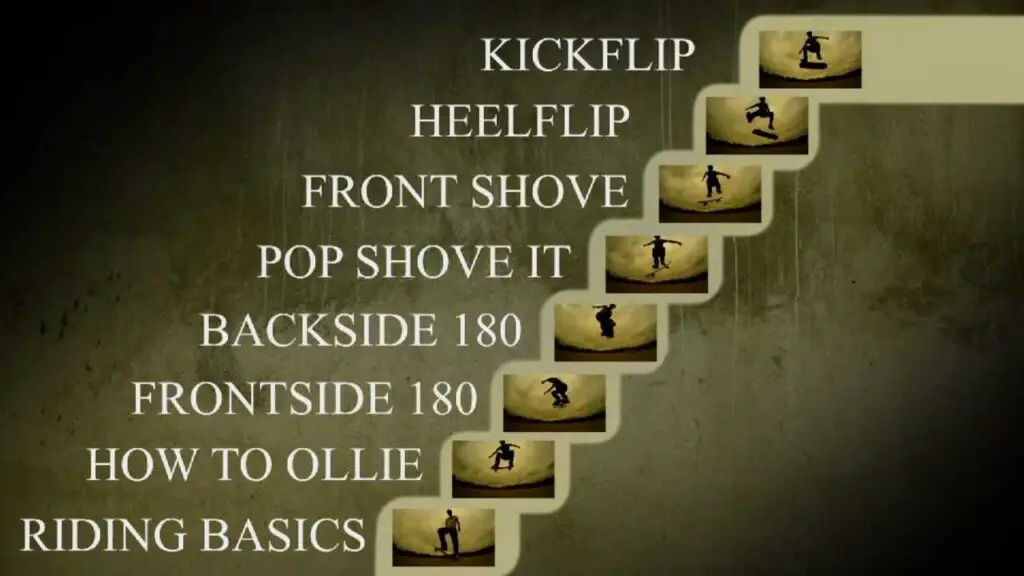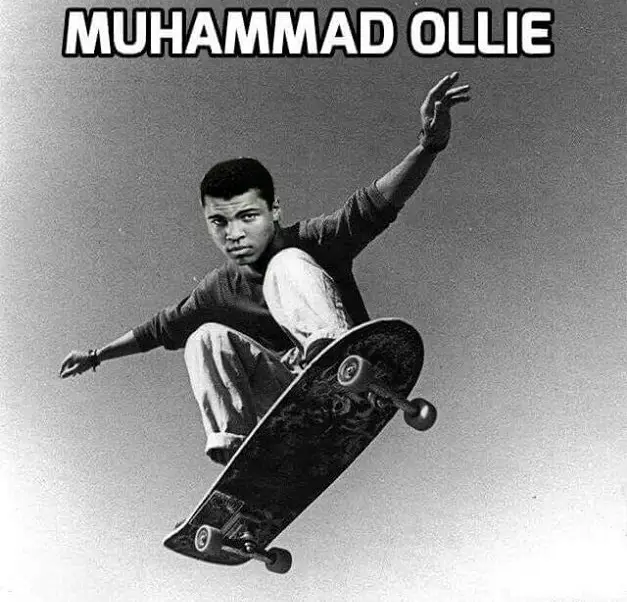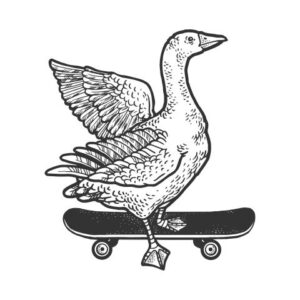So you’ve struggled for weeks or maybe even months and you learned how to do an ollie.
Congratulations you beast.
Next, you’re wondering what to learn now. What is the next logical trick to learn after an ollie?
Well, the answer isn’t so clear. Let me explain.
What Trick to Learn After an Ollie
Shuv-its (Shov-its)
Some of you might have learned this trick already before the ollie, but if you haven’t then now is a great time to learn.
The reason learning a Shuv-it now is perfect is because it primes you to learn Pop Shuv-its immediately after. You start to get used to spinning the board underneath you and Shuv-its are also very satisfying to learn. You won’t struggle for weeks to learn this, but will likely land a few on the first afternoon you try them.
A Shuv-it is done by flicking your backfoot back to spin your board and you jump straight up. Keep your shoulders flat and be sure you aren’t jumping forward too much. Excuse my sloppy Shuv-it in the gif. I realized I have absolutely no video of myself doing Shuv-its and that was the only clip I could find.
Pop Shuv-its
Pop Shuv-its are done by doing a Shuv-it, but while popping and doing an ollie.
You don’t need to learn Shuv-its first to learn Pop Phuv-its, but it helps to do so. I actually learned my Pop Shuv-its before learning to do a Shuv-it. Remember there is no special order in which you need to learn tricks.
I love a good Pop Shuv-it and getting a nice high and smooth one is always satisfying. This trick is also quite a bit easier than Kickflips or Heelflips so most people start by learning Pop Shuv-its after learning to Ollie.
Start by not popping too high until you get better control of your board.
Frontside 180s
There really are two tricks that most people go for after learning an ollie. The first is Pop Shuv-it and the other is the Frontside 180.
Frontside 180s can take a surprisingly long time to learn well and get consistently. However, once you start trying them, you will likely land your first one pretty quickly. I spent about a month and a half trying to learn this trick consistently (landing it more than 75% of the time) and it took me about 16 total hours of dedicated practice.
Again Frontside 180s are much easier than Kickflips or Heelflips so most people gravitate to this trick after Ollies. I personally learned Ollies, then Pop Shuv-its, and then Frontside 180s.
Kickflip or Heelflip
Kickflips are what most beginner skaters want to learn as soon as possible.
The trick is probably as famous as an ollie and many people love to yell “Do a Kickflip!” to random skaters as they pass by. Any little kid who doesn’t understand skateboarding will think you suck if you can’t do them.
So, if you are so inclined, it is perfectly ok to start learning Kickflips after learning your ollie. Just understand that a Kickflip is a hard trick. It will take much longer to learn them compared to Frontside 180s or Pop Shuv-its. So you might get discouraged if you go straight for this trick.
The same goes for a Heelflip, but no one will randomly yell for you to do a Heelflip. Also, Heelflips are just a little less sexy than the Kickflip. Regardless, for some people, Heelflips come easier for them so give it a try.
After you have learned your Ollie then there is nothing stopping you from learning these tricks besides practice. So get out there and skate today or tonight. Skate now and not later.
General Trick Progression
| Group | Tricks to Learn |
| 1 | Manual, Shuv-it, Front Shuv-it, kickturn, Revert, Ollie, Caveman, Slappies |
| 2 | Pop Shuv-it, Frontside 180, Kickflip, Backside 180, Heelflip, Front Pop Shuv-it, Boardslide |
| 3 | Varial flips, Tre flip, 50-50 Grind, grind variations |
| 4 | Wall rides, 360 spins and variations, varial flip variations, whatever else |
Tricks aren’t really in some linear sequence that allows you to unlock other tricks. It is more as if they are in little clusters or groups of difficulty.
Look at the table above. This is just to give you an idea of the general groupings of tricks. You can see absolute beginners will be in Group 1 learning things such as kick turns. Once you can Ollie, everything in Group 2 suddenly opens up.
At this point you can learn anything in Group 2 and order really doesn’t matter so much. Once you learn a few tricks in Group 2, you might try to learn a Group 3 trick. For example, you could learn Tre Flips without ever learning Backside 180s. This is more common than you think.
There is No Proper Progression

There are alot of people who follow something like Braille’s progression guide and think that there is a specific way to progress in skating. This is simply not true.
Really with it comes to learning tricks in skateboarding, you should learn what you’re interested in doing. While, yes, you can learn to do a Noseblunt without first learning to Ollie, generally the idea of a linear progression is kind of silly. Once you learn to Ollie, so many tricks and variations open up to you and you can take your skating in whatever direction you want to.
Maybe you love grinds and slides so you focus on skating ledges. Maybe you want to focus on technical street skating so you focus on learning Ollies to manuals and getting better board control. The world is your oyster. Or the skateboard is your world. I don’t know.
Some people can do Pressure Flips and Hospital Flips, but can’t do a 50-50 Grind. And that’s ok.
Skate how you want to.
Work on Mastering Your Ollie

It’s always a bit strange for me to hear beginners say they “learned” the Ollie and they’re ready for their next trick. They’re right of course, but I don’t think of the Ollie or any trick really as some static thing. Your tricks, Ollie included, are always evolving and getting better as you skate.
You can learn to ollie over obstacles, ollie into stalls, make your ollie higher, or ollie into manuals. There is so much to do with just this one trick that you could only Ollie for an entire year and still have fun skating. Additionally, most beginner’s Ollies have poor form or aren’t very high. They also might not be consistent or have good control of the board.
I’m not trying to discourage you from learning new tricks.
Instead, just understand that your Ollie and other tricks will continuously improve over time as you develop as a skater. My ollie took months and months to improve even after I initially learned it. I still try to practice and work on it from time to time.
So don’t stop practicing your Ollies just because you landed a few.
If you want to learn how to practice in a way that will let you progress the fastest, check out my guide with action steps to help you get started.
Conclusion
So that’s it.
Most skaters try to learn a Pop Shuv-it or Frontside 180 after an Ollie. However, there are many tricks that can be learned after an Ollie. There is no specific sequence of tricks for you to learn and really tricks to learn fall more in clusters of difficulty.
Choose the trick that you want to learn and isn’t completely out of your skill level. Just skate how you want and learn what interests you.
This is the way.
Anyway, I hope that helped. Thanks for reading, and look out for content from Board and Wheels.
Sources
I have other guides about doing an Ollie meant to specifically answer different aspects that might be helpful for you. You’ve already learned an Ollie, but you can see some of my ollie articles that will help you improve your Ollie below:
- How to Ollie While Moving- A Visual Guide
- How to Ollie and Skate a Curb- A Visual Guide
- How to Ollie Over an Obstacle
There are some other great forum resources and videos where other skaters weigh in on this question:



